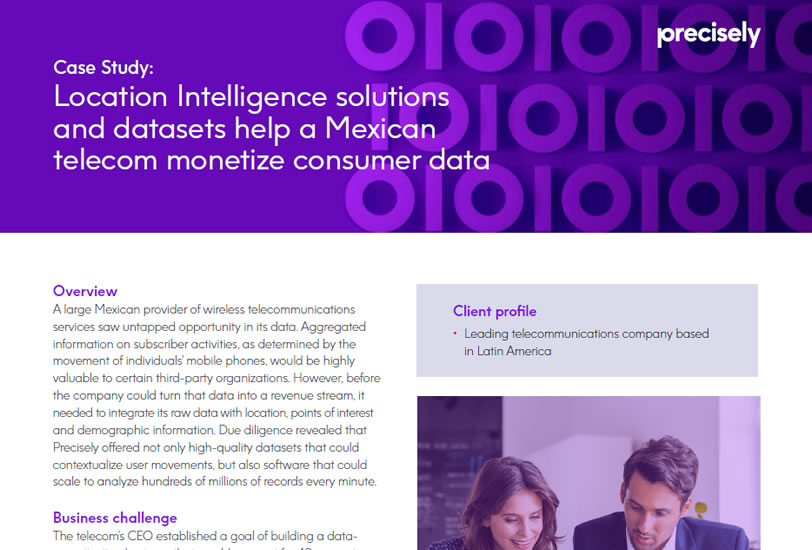Customer Story
Location Intelligence Solutions and Datasets Help a Mexican Telecom Monetize Consumer Data
A large Mexican provider of wireless telecom services saw untapped opportunity in its data. Aggregated information on subscriber activities, as determined by the movement of individuals’ mobile phones, would be highly valuable to certain third-party organizations. However, before the company could turn that data into a revenue stream, it needed to integrate its raw data with location, points of interest and demographic information. Due diligence revealed that Precisely offered not only high-quality datasets that could contextualize user movements, but also software that could scale to analyze hundreds of millions of records every minute.
The CEO of the telecom established a goal of building a data-monetization business that would account for 40 percent of corporate revenue within a few years. The company was already collecting point-in-time location data for each mobile-phone user on its network. Its data science team saw an opportunity to aggregate and segment this data, then apply artificial intelligence (AI) to provide external customers — such as transit companies or businesses selling various types of advertising — with insights into the demographics and lifestyle of certain groups of consumers. Possibilities for monetization were significant. An electronic-billboard business, for example, would be very interested in understanding the interests of consumers passing through a particular intersection at specific times of day or days of the week.
As a first step in the project, the data science group planned to develop an enormous database identifying each subscriber’s home and work location based on movement of the individual’s phone. Subsequently, they would create additional databases to house details such as the frequency with which each specific mobile user visits a bar, yoga studio, grocery store, or shopping mall.
The data science team needed a platform on which to develop its location-based big data architecture. They also needed top-quality, AI-consumable data. In Precisely, they found both.
The telecom deployed Spectrum Spatial for Big Data, a geospatial data management and integration platform with a distributed architecture that can scale to support the telecom’s massive data volume. Spectrum Geocoding for Big Data is used to map every point-in-time location of each mobile device to the nearest address. Having this information enabled the data science team to develop its home-vs.-work location table. The table is valuable in its own right: An insurance company, for example, might compare the table with its customer database to ensure that its information is up to date. The home-vs.-work location table is also foundational to building additional datasets — for instance, a project to identify frequency of visits to a certain type of retail establishment could start by ruling out time spent at work or at home.
